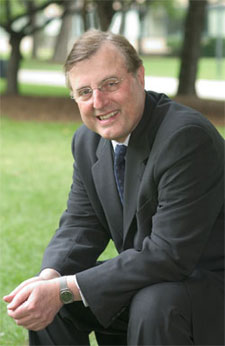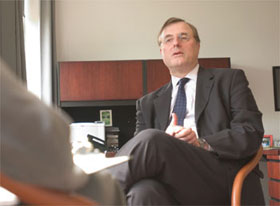
Outside, it’s an idyllic summer day in Chicago. Inside the office of IIT President Lew Collens, more than the good weather is providing the energy. Tonight, a gala will signal the much-anticipated unveiling of the newly restored S. R. Crown Hall. It’s also the first day of classes, which has Collens particularly excited.
“IIT is a great place. I just walked through the campus center, and it’s humming and alive with students. I just love it,” says Collens.
This is an important time for Collens’ and for the university. As he begins his 16th year as president, he is leading IIT in a critical self-study spurred by the North Central Association Committee re-accreditation process, which measures the effectiveness of universities at meeting their goals. Simultaneously, he is spearheading the creation of the 2010 Plan, which will define IIT’s academic priorities for the coming half-decade.
Collens shares with IIT Magazine the details surrounding the re-accreditation, the progress of the 2010 Plan, and his outlook on the future of IIT.

As you embark on these two new initiatives, looking back at the past 10 years, what are some of the most notable successes at IIT?
Our successes in the past decade can be traced to the National Commission for IIT, which was created in 1994 to look at the future of the university. What came out of that process were several key things. One was the creation of our Interprofessional Projects (IPRO) program, which today is the cornerstone of our academic approach.
The second was the decision to rebuild IIT’s campus and to be a strong force in rebuilding the neighborhood. By all measures that has been a dramatic success. We have had great support from the city and the state. We still have a lot of work to do. We have just completed an important renovation of Crown Hall, and Wishnick Hall and undergraduate labs across campus are in the midst of major transformations.
But the most important success is the quality of our students, faculty, and educational programs. At the undergraduate level, we have had a remarkable increase in the quality of our students as measured by SAT and ACT scores. We have done very well in faculty recruiting, and are fortunate to have so many faculty members who are great teachers, scholars, and researchers.
In the past decade the Pritzker Institute of Biomedical Science and Engineering has led a dramatic expansion in all of the life sciences. We were able to transfer the ownership of IIT Research Institute to its employees, enhancing they're well being as well as the university endowment. We also should take pride in the quality of our Board of Trustees and the great work they continue to do, including leadership that has brought several hundred million in philanthropy to the university.
What were important lessons gleaned from the National Commission for IIT that are helping with the creation of the 2010 Plan?
To make sure to think broadly and creatively, to acknowledge weaknesses, and to understand what we need to do better and what we can do better. The commission challenged the institution with the idea of the IPRO program. We knew it was a very difficult thing to do. The faculty rose to the occasion, and it worked. What's important is that we challenged ourselves.
How does the 2010 Plan relate to the re-accreditation process?
The 2010 Plan is the umbrella for defining IIT’s strategic initiatives, and it is being done in conjunction with the re-accreditation process. With re-accreditation, we analyze for the committee all aspects of the university: our strengths, weaknesses, opportunities, and threats. They don’t tell us what kind of school to be. They ask us to define the kind of school that we want to be, and ask us what kind of school we are telling the world we are. Think of it as a truth in disclosure.
What have emerged as the key academic priorities in the 2010 Plan?
It is important to note that we are in the early stages of planning and the university community has not yet come to a decision on the priorities for the next five years. Whatever emerges from the planning process, there is one constant: We are committed to providing a high-quality educational experience for our exceptional students. During the past several years we have developed several areas that have the potential to greatly impact the institution in terms of reputation, resource enhancement, and research.
We have invested heavily in the life sciences to ensure that the university is well positioned in this area of primary importance to economic and social development in the years ahead.
We have invested heavily in creating one of the best undergraduate programs in the nation. Our interprofessional, entrepreneurship, and leadership program provide our students with a distinctive opportunity for education and personal growth.
How will the finalized 2010 Plan help IIT to distinguish itself from peer institutions?
We are an excellent university, but we live in a very competitive environment. The students we want are among the best in the world. So we have to work hard to continue to enhance our reputation to enable us to recruit the best students. The same is true with regard to faculty. There are nearly 4,000 colleges and universities in the United States. We are easily in the top 2 percent, but within that 2 percent it’s a whole different competitive experience. A strong faculty, diverse student body, and quality overall resources will allow us to continue to stand out.
With the successful implementation of the 2010 Plan, can you describe how IIT will look 10 years from now?
Academically, we will be one of the national leaders in the commercialization of life science research and have significant enrollments in all phases of life sciences. I think University Technology Park At IIT will have matured to be a remarkable engine for technology commercialization.
IIT will be stronger than it is today. Facilities will be better. I expect that we will have a larger student body and a stronger financial platform. We’ve made a lot of progress, but we still need to strengthen it.
Just as anybody who hasn’t visited the campus in 10 years returns to find changes, hopefully the campus will look better than it does now. It looks great, but we need to continue to enhance it. Overall, I think that 10 years from now this will be an even more exciting place to teach and learn.